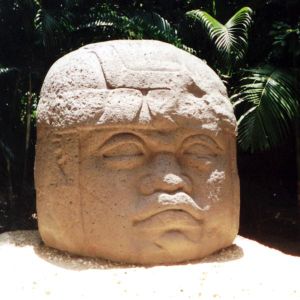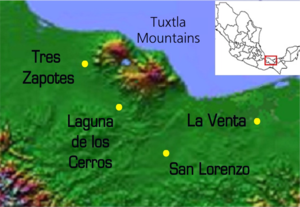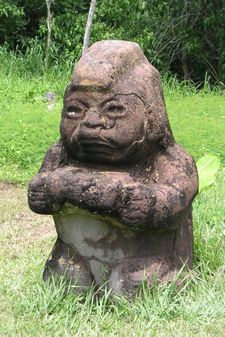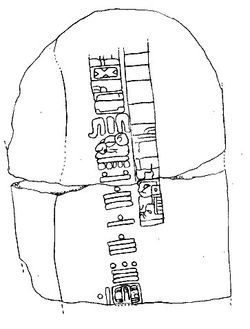Olmec
2007 Schools Wikipedia Selection. Related subjects: Ancient History, Classical History and Mythology
The Olmec were an ancient Pre-Columbian people living in the tropical lowlands of south-central Mexico, roughly in what are the modern-day states of Veracruz and Tabasco on the Isthmus of Tehuantepec. Their immediate cultural influence went much further though, Olmec artwork being found as far afield as El Salvador. The Olmec predominated in their lands from about 1200 BC to about 400 BC and they are, in fact, claimed by many to be the progenitors and mother culture of every primary element common to later Mesoamerican civilizations.
Overview
The Olmec Heartland is characterized by swampy lowlands punctuated by low hill ridges and volcanoes. The Tuxtlas Mountains rise sharply in the north, along the Gulf of Mexico's Bay of Campeche. Here the Olmecs constructed permanent city-temple complexes at several locations, among them San Lorenzo Tenochtitlán, La Venta, Tres Zapotes, Laguna de los Cerros, and La Mojarra. They also had great influence beyond the heartland: from Chalcatzingo, far to the west in the highlands of Mexico, to Izapa, on the Pacific coast near what is now Guatemala, Olmec goods have been found throughout Mesoamerica during this period. In this heartland, the first Mesoamerican civilization would emerge and reign from 1200–400 BC.
The Olmec are thought to be the first civilization in the Western Hemisphere to develop a writing system. Symbols found in 2002 and 2006 date to 650 BC and 900 BC precede the oldest Zapotec writing, dated to about 500 BC. Some challenged the 2002 find, suggesting that it was not writing, however, the discovery of a stone inscription in 2006 mostly settled the dispute. There are other later hieroglyphs known as " Epi-Olmec", and while there are some who believe that Epi-Olmec may represent a transitional script between an earlier, unknown Olmec writing system and Maya writing, the matter remains unsettled.
The Olmec, whose name means "rubber people" (see below), were perhaps the originators of the Mesoamerican ballgame so prevalent among later cultures of the region and used for recreational and religious purposes—certainly they were playing it before anyone else has been documented doing so.
Their religion developed all the important themes (an obsession with mathematics and with calendars, and a spiritual focus on death expressed through human sacrifice) found in successor groups. Finally, their political arrangements of strongly hierarchical city-state kingdoms were repeated by nearly every other Mexican and Central American civilization that followed.
While the actual ethnicity of the Olmec remains unknown speculations on the topic has been set forth. In 1976 Lyle Campbell and Terrence Kaufman published a paper which argued that the existence of a number of loanwords from a semantically very fundamental domain for mesoamerican cultures which have apparently spread from a Mixe-Zoquean language into many other Mesoamerican languages, can be seen as an indicator that the first "highly civilized society" of Mesoamerica spoke a language which is an ancestor of the Mixe-Zoquean languages, and that they spread their own vocabulary of terms particular for their culture to other peoples of Mesoamerica. Since the Mixe-Zoquean languages still are, and historically are known to have been, spoken in an area corresponding roughly to the "Olmec heartland", and since the Olmec culture is now generally regarded as the first "high culture" of Mesoamerica, it has generally been regarded as probable that the Olmec spoke a Mixe-Zoquean language.
Etymology of the name "Olmec"
The name "Olmec" means "rubber people" in Nahuatl, the language of the Mexica ("Aztec") people. It was the Aztec name for the people who lived in this area at the much later time of Aztec dominance. Ancient Mesoamericans, spanning from ancient Olmecs to Aztecs, extracted latex from Castilla elastica, a type of rubber tree in the area. The juice of a local vine, Ipomoea alba, was then mixed with this latex to create rubber as early as 1600 BC . The word "Olmec" also refers to the rubber balls used for their ancient ball game. Early modern explorers applied the name "Olmec" to the rediscovered ruins and art from this area before it was understood that these had been already abandoned more than a thousand years before the time of the people the Aztecs knew as the "Olmec". It is not known what name the ancient Olmec used for themselves; some later Mesoamerican accounts seem to refer to the ancient Olmec as "Tamoanchan".
History
Early history
Olmec culture originated at its base in San Lorenzo Tenochtitlan, where distinctively Olmec features begin to emerge around 1150 BC. The rise of civilization here was probably assisted by the local ecology of well-watered rich alluvial soil, encouraging high maize production. This ecology may be compared to that of other ancient centers of civilization: Mesopotamia and the Nile valley. It is speculated that the dense population concentration at San Lorenzo encouraged the rise of an elite class that eventually ensured Olmec dominance and provided the social basis for the production of the symbolic and sophisticated luxury artifacts that define Olmec culture. Many of these luxury artifacts, for example jade and magnetite, must have come from distant locations and suggests that early Olmec elites had access to an extensive trading network in Mesoamerica.
La Venta
The first Olmec centre, San Lorenzo, was all but abandoned around 900 BC at about the same time that La Venta rose to prominence. Environmental changes may have been responsible for this move, with certain important rivers changing course. A wholesale destruction of many San Lorenzo monuments also occurred around this time, circa 950 BC, which may point to an internal uprising or, less likely, an invasion.
In any case, La Venta was the most prominent Olmec centre from 900 BC until its abandonment around 400 BC. During this period, the Great Pyramid and various ceremonial complexes were created at La Venta, and the baffling Massive Offerings and mosaics were buried. Around 400 BCE, La Venta also came to an end, although the importance of the ceremonial complexes apparently outlasted the Olmec state or culture.
Decline
It is not known with any clarity what happened to the Olmec culture. The Tres Zapotes site continued to be occupied well past 400 BC, but without the hallmarks of the Olmec culture. Some researchers have labelled this period the "Epi-Olmec" culture. This post-Olmec culture has features similar to those found at Izapa, some distance to the southeast.
Within a few hundred years of the abandonment of the last Olmec cities, successor cultures had become firmly established, most notably the Maya to the east and the Zapotec to the southwest.
Beyond the heartland
Olmec-style artifacts, designs, figurines, monuments and motifs have been found in the archaeological records of sites hundreds of miles (or kilometers) outside the Olmec heartland. These sites include:
- Tlatilco and Tlapacoya, major centers of the Tlatilco culture in the Valley of Mexico, where artifacts include hollow baby-face motif figurines and Olmec designs on ceramics.
- Chalcatzingo, in Valley of Morelos, which features Olmec-style monumental art and rock art with Olmec-style figures.
- Teopantecuanitlan, in Guerrero, which features Olmec-style monumental art as well as city plans with distinctive Olmec features.
Other sites showing possible Olmec influence include Abaj Takalik in Guatemala, and the Juxtlahuaca and Oxtotitlan cave paintings are attributed by many researchersto the Olmecs.
Many theories have been advanced to account for the occurrence of Olmec influence far outside the heartland. Some such theories include long-range trade by Olmec merchants, Olmec colonization of other regions, Olmec artisans travelling to other cities, conscious imitation of Olmec artistical styles by developing towns -- and some also suggest Olmec military domination outside of their heartland.
According to the school of thought promoted by Christine Niederberger and developed in particular by Caterina Magni , the Olmec culture was a multi-ethnic unit and pluri-linguistic culture covering a vast part of the Mesoamerica, in the period from 1200 BC to about 500 BC.Its presence is attested on old levels of occupation on the Coast of the Gulf, in the Valley of Mexico and along the Pacific coast in the States of Guerrero, Oaxaca and Chiapas. Beyond the Mexican borders, Olmec artifacts are found south to Costa Rica. Some major centers being San Lorenzo (Veracruz), La Venta (Tabasco), Chalcatzingo (Morelos), Teopantecuanitlán (Guerrero) and Abaj Takalik (or Takalik Abaj) in Guatemala.
This is contrast to the more traditional view that recognizes a distinct Olmec heartland (see map).
Olmec art
Olmec artforms remain in works of both monumental statuary and small jadework. Much Olmec art is highly stylized and uses an iconography reflective of a religious meaning to the artworks. Some Olmec art, however, is surprisingly naturalistic, displaying an accuracy of depiction of human anatomy perhaps equaled in the pre-Columbian New World only by the best Maya Classic era art. Common motifs include downturned mouths and slit-like slanting eyes, both of which can be seen as representations of "were-jaguars". Olmec figurines are also found abundantly in sites throughout the Formative Period.
In addition to human subjects, Olmec artisans were adept at animal portrayals, for example, this ceramic ancient Olmec "Bird Vessel", dating to circa 1000 BC. Ceramics are produced in kilns capable of exceeding approximately 900 ° C. The only other prehistoric culture known to have achieved such high temperatures is that of Ancient Egypt .
Olmec colossal heads
Perhaps the best-recognized Olmec art are the enormous helmeted heads. As no known pre-Columbian text explains these, these impressive monuments have been the subject of much speculation. Given the individuality of each, these heads seem to be portraits of famous ball players or perhaps kings rigged out in the accoutrements of the game.
According to Grove, the unique elements in the headgear can also be recognized in headdresses of human figures on other Gulf Coast monuments, suggesting that these are personal or group symbols.
The heads range in size from the Rancho La Corbata head, at 3.4 m high, to the pair at Tres Zapotes, at 1.47 m. Some sources estimate that the largest weighs as much as 40 tons, although most reports place the larger heads at 20 tons.
The heads were carved from single blocks or boulders of volcanic basalt, quarried in the Tuxtlas Mountains. The Tres Zapotes heads were sculpted from basalt found on San Martin Volcano. The lowland heads were possibly carved from the Cerro Cintepec, now known as Cerro San Martin Pajapan. It is possible that the heads were carried on large balsa rafts from the Llano del Jicaro quarry to their final locations, or more likely dragged and rafted down rivers. To reach La Venta, roughly 80 km (50 miles) away, the rafts would have had to move out onto choppy waters of the Bay of Campeche.
Some of the heads, and many other monuments, have been variously mutilated, buried and disinterred, reset in new locations and/or reburied. Whether these actions were undertaken as a ritual or as a result of a conflict or conflicts is yet to be decided.
There have been 17 colossal heads unearthed to date.
| Site | Count | Designations |
|---|---|---|
| San Lorenzo | 10 | Colossal Heads 1 through 10 |
| La Venta | 4 | Monuments 1 through 4 |
| Tres Zapotes | 2 | Monuments A & Q |
| Rancho la Corbata | 1 | Monument 1 |
Pottery and trade
In March 2005, a team of archaeologists used NAA (neutron activation analysis) to compare over 1000 ancient Mesoamerican Olmec-style ceramic artifacts with 275 samples of clay so as to "fingerprint" pottery origination. They found that "the Olmec packaged and exported their beliefs throughout the region in the form of specialized ceramic designs and forms, which quickly became hallmarks of elite status in various regions of ancient Mexico".
In response, in August 2005 another study, this time using petrography, found that the "exchanges of vessels between highland and lowland chiefly centers were reciprocal, or two way." . Five of the samples dug up in San Lorenzo were "unambiguously" from Oaxaca. According to one of the archaeologists conducting the study, this "contradicts recent claims that the Gulf Coast was the sole source of pottery" in Mesoamerica.
The results of the INAA study were later defended in March 2006 in two articles in Latin American Antiquity. Because the INAA sample is much larger than the petrographic sample (a total of over 1600 analyses of raw materials and clays vs. approximately 20 pottery thin sections in the petrographic study), the authors of the Latin American Antiquity papers argue that the petrographic study cannot possibly overturn the INAA study.
Religion
: See main article: Olmec mythology
Olmec mythology has left no documents comparable to the Popul Vuh from Maya mythology, and therefore any exposition of Olmec mythology must rely on interpretations of surviving monumental and portable art and comparisons with other Mesoamerican mythologies. Olmec art shows that such deities as the Feathered Serpent and the Rain Spirit were already in the Mesoamerican pantheon in Olmec times.
Olmecs and the development of the zero
There has been speculation that the Olmecs were the first culture in the Americas to develop the zero.
The Long Count calendar used by the Maya required the use of zero as a place-holder within its vigesimal (base-20) positional numeral system. A shell glyph was used as a zero symbol for these Long Count dates, the earliest of which (on Stela 2 at Chiapa de Corzo, Chiapas) has a date of 36 BCE. Since the eight earliest Long Count dates appear outside the Maya homeland, it is assumed that the use of zero in the Americas predated the Maya and was possibly the invention of the Olmecs. Indeed, many of the earliest Long Count dates were found within the Olmec heartland, although the fact that the Olmec civilization had come to an end by the 4th century BCE, several centuries before the earliest known Long Count dates, argues against the zero being an Olmec invention.
History of scholarly research on the Olmec
Olmec culture was unknown to historians until the late 19th century. In 1862 the fortuitous discovery of the first colossal head near Tres Zapotes, ( Veracruz) by José Melgar y Serrano marked the first significant rediscovery of Olmec artifacts.
Frans Blom of Tulane University made the first detailed descriptions of a number of Olmec sites in the 1920s. However early Mesoamericanists at first assumed the Olmec were likely no earlier than the Classic era. Matthew Stirling of the Smithsonian Institution conducted the first detailed scientific excavations of Olmec sites in the 1930s and 1940s. Stirling, along with art historian Miguel Covarrubias, became convinced that the Olmec predated most other known Mesoamerican civilizations. This was confirmed with the development of radiocarbon dating.
Other important archaeologists investigating the Olmec include Eduardo Conteras and Michael D. Coe.
Alternative origin speculations
In part because the Olmecs developed the first Mesoamerican civilization and in part because so little is known of the Olmecs (relative, for example, to the Maya or Aztec), a wide number of Olmec alternative origin speculations have been put forth. Although several of these speculations, particularly the theory that the Olmecs were of African origin, have become well-known within popular culture, they are not considered credible by the vast majority of Mesoamerican researchers.







